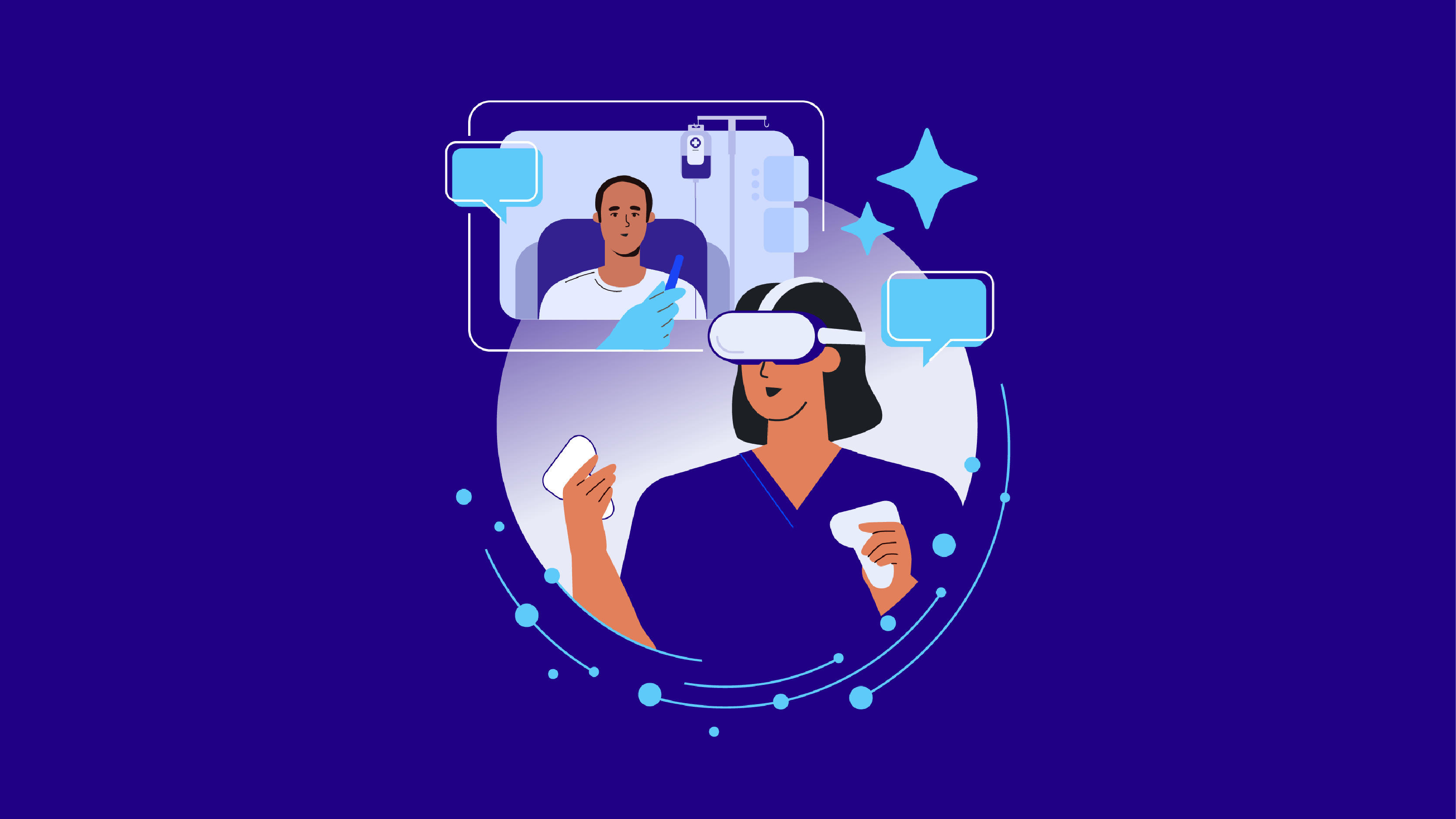
Table of Contents
Name of the heading
1- Start your table with the syntax {start-table}
2 - Add an H3 Heading to create a new column (this will be the column title)
3 - List cells as bullet points in a List element
4 - End your table with the syntax {end-table}
Nursing education faces a challenge: how do we prepare the next generation of nurses with comprehensive, practical skills amidst the constraints of limited faculty resources? As nursing programs seek to equip students with essential skills and knowledge, finding a balance between quality education and using faculty resources judiciously has become increasingly crucial.
By integrating peer-to-peer facilitation in UbiSim's virtual reality (VR) platform, you can create a learning environment where students actively participate in each other's education. This method not only alleviates the strain on faculty resources but also enhances the learning experience for students.
We'll explore one way to do peer-to-peer facilitation with VR technology can be implemented in nursing education and what benefits it can offer for a sustainable path forward.

What it takes to run peer-to-peer facilitation sessions:
We’re going to cover how to structure a 3-hour simulation experience for 12 students (six groups of two students).
1-hour prebrief: To start, prebrief (all 12 learners) in the web portal. Any recommended UbiSim tutorials can be done in VR.


Preparation
UbiSim’s team of nurse educators has developed preparation activities for each VR simulation that are ready for educators to implement. These preparation activities are created according to the purpose and learning objectives of the simulation-based experience to ensure learners are prepared and can meet the scenario objectives. Learners instantly access robust preparation materials including a scenario introduction with an SBAR report, scenario medications, and documents such as lab results and diagnostic reports. Educators are able to easily customize the preparation activities and tailor them based on the learner level.
Briefing
UbiSim’s ready-to-go briefing reinforces a safe learning environment, orients the learner to VR, and explains the role of the learner. Curated tutorials for each VR scenario provide learners with an opportunity to don the VR headset, explore the simulated hospital room, and operate the virtual equipment. Each tutorial helps learners to have confidence and understand how to interact with the patient, equipment, and environment prior to starting the scenario. Educators can easily customize the briefing if desired. When using the UbiSim platform we recommend an open area measuring at least 7 feet x 7 feet for each learner that is engaged in the VR scenario.
20-minute VR simulation: Run six groups with two students in each group. One student is an active participant in VR and one student is a peer facilitator on the web. The facilitator’s job in UbiSim is to trigger dialogue from the “Facilitator View” on a laptop while the active participant(s) are in VR. The dialog is preset (and only dialog that makes sense/is applicable to the patient’s current condition), and there is a menu of options for the facilitator to choose from for the patient, family members, and other providers. The scenario unfolds according to the active participant's actions (or inaction)
20-minute VR simulation: Students switch roles and repeat the scenario, using deliberate practice to improve performance. Now, the active participant who was in VR is the facilitator triggering the dialog.
20-minute feedback session: Each pair reviews session feedback from both sessions
(on the web). UbiSim scenarios unfold according to the active participant's actions (or inaction) during the scenario. Learners can immediately see their critical actions, performance gaps, and additional actions with robust, evidence-based feedback in the session feedback report.
1-hour debrief, guided reflection & quiz: Debrief all 12 learners using the web portal with many options. Faculty can have students complete guided reflection individually or in pairs and can also use the guided reflection questions to facilitate a debriefing for the group of all 12 students. Faculty can also initiate conversations using the post-simulation quiz or have learners complete the quiz individually, in pairs, in groups, or all together.
Benefits of peer-to-peer facilitation:
- Enables a single instructor to guide multiple groups of students simultaneously
- Enhances collaborative learning
- Improves communication skills
- Enriches understanding through teaching others
- Increase in clinical accuracy and a decrease in practical mistakes
- Helps solidify learning
- Supports training for the Next Gen NCLEX
Final thoughts
How well could you scale your nursing program and save faculty resources if you were able to utilize UbiSim’s virtual reality platform via peer-to-peer facilitation? Request a demo of UbiSim today. We’ll even let you borrow a headset!
FAQs
Heading 1
Heading 2
Heading 3
Heading 4
Heading 5
Heading 6
Lorem ipsum dolor sit amet, consectetur adipiscing elit, sed do eiusmod tempor incididunt ut labore et dolore magna aliqua. Ut enim ad minim veniam, quis nostrud exercitation ullamco laboris nisi ut aliquip ex ea commodo consequat. Duis aute irure dolor in reprehenderit in voluptate velit esse cillum dolore eu fugiat nulla pariatur.
Block quote
Ordered list
- Item 1
- Item 2
- Item 3
Unordered list
- Item A
- Item B
- Item C
Bold text
Emphasis
Superscript
Subscript
Explore more

From 30 Minutes to 3: How AI Enhanced Analytics Transforms Debriefing Preparation
AI Enhanced Analytics: Scenario Performance Data now available in UbiSim's Version 1.19
.jpg)
Behind the Scenes: How We Brought Incisions & Dressings to Life in VR
How the UbiSim team built a VR system displaying 300+ distinct incision states—balancing clinical accuracy, technical constraints, and nursing education needs.
.jpg)
Step Inside the Room of Errors: Playful Exploration, Serious Skills
Learn how UbiSim's Room of Errors transforms nurse training through investigative play. Students spot hidden safety risks and build situational awareness.



